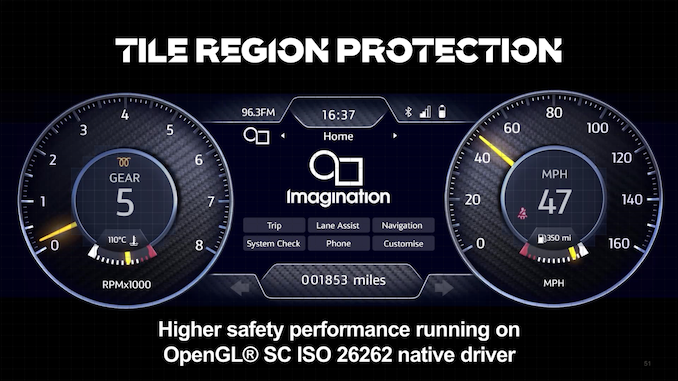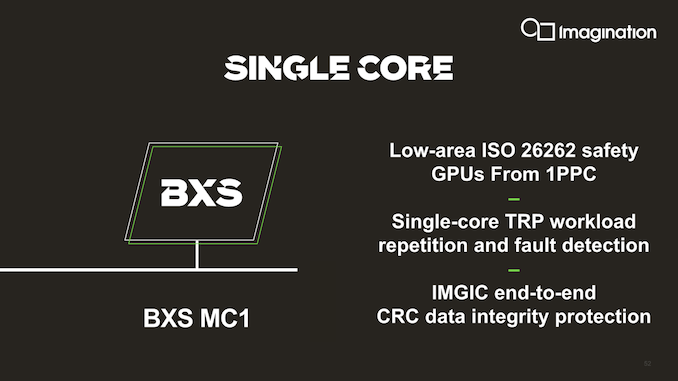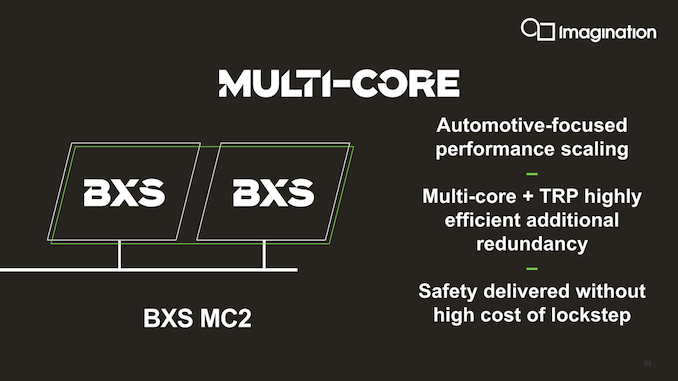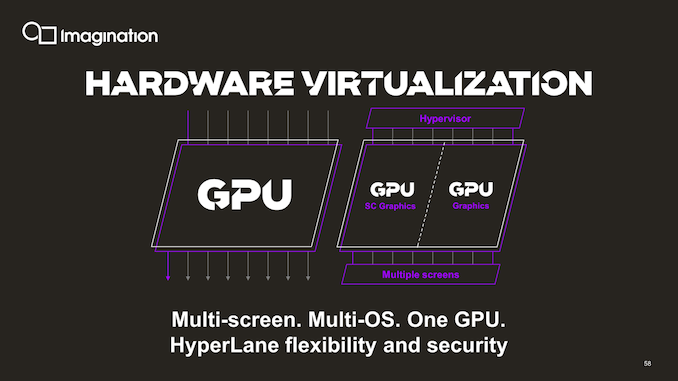Imagination Announces B-Series GPU IP: Scaling up with Multi-GPU
by Andrei Frumusanu on October 13, 2020 4:00 AM EST- Posted in
- GPUs
- Imagination Technologies
- SoCs
- IP
Introducing BXS Series: Functional Safety for Autonomy
Besides targeting higher performance design targets, an area where Imagination is putting a higher level of focus on is the automotive and industrial markets. To cover these use-cases, Imagination is today also launching the new “BXS” series of GPU IP – where the S stands for safety.
The new GPU IP line-up mirrors the standard BXT, BXM and BXE configurations, but adds support for ISO 26262 / ASIL-B functional safety features.
Imagination is introducing a new feature called “Tile Region Protection” in which a configurable region of render tiles on the render frame can be marked as safety critical, and for which the GPU can check for correct execution and rendering, allowing it to be ISO 26262 certified.
TRP is implemented from the smallest BXE-equivalent BXS GPU (Frankly Imagination could have done better here than calling the whole safety line-up BXS), allowing for work repletion to achieve fault detection. Furthermore, Imagination allows for end-to-end data integrity protection via CRC checking of all data going in and out of the GPU, further helping the IP achieve safety requirements.
TRP require a single GPU to repeat work, which in turn would mean reduced performance in a system. A more performance-oriented way of scaling things would be a multi-GPU implementation.
A multi-GPU configuration in an automotive design would also server the purpose of partitioning the GPUs for multiple independent workloads; whilst in a consumer implementation you would expect the GPUs to mostly act and appear as a single large unit to a host, automotive use-cases could also have the multiple GPUs act completely independently from each other. It’s also possible to mix- and match GPUs, for example a 4-core implementation could have 3 partitions, with two GPUs working together to pool up resources for a more demanding task such as the infotainment system, while two other GPUs would be handling other independent workloads.
Imagination naturally also continues to support hardware virtualisation within one single GPU with up to 8 “hyperlanes” (guests). So, you could split up a 2-core design into 3 partitions, such as depicted above.
Beyond the addition of safety critical features on the BXS series, the automotive IP also features some specific enhancements in the microarchitecture that allows for better performance scaling for workloads that are more unique to the automotive space. One such aspect is geometry, where automotive vendors have the tendency to use absurd amounts of triangles. Imagination says they’ve tweaked their designs to cover these more demanding use-cases, and together with some MSAA specific optimisations they can reach up to a 60% greater performance for these automotive edge-cases, compared to the regular non-automotive IP.
















74 Comments
View All Comments
HVAC - Tuesday, October 13, 2020 - link
You don't win market share without a product offering in the market. If we only did things for which we could be certain of success, we would all still be huddled into a teeming mass near central Asia.EthiaW - Tuesday, October 13, 2020 - link
Since there has been no application of Imagination's top tier configurations after Apple abandoned them (from the Furian generation, 2017), leaving that market for small budget gpus, likely those in wearable devices will be justifiable.They having been working on high-end mobile gpus for some 5 years without market share, sadly.
Zingam - Wednesday, October 14, 2020 - link
This way of thinking, Mr.... that's why you are no Bill Gates.Yojimbo - Tuesday, October 13, 2020 - link
Because the Chinese have a lot of money to throw around and they desperately want to develop market-controlling technologies. They don't control that many Western IP companies. Might as well try to make use of the few they do control.Zingam - Wednesday, October 14, 2020 - link
I doubt that Chinese have that much money... They are just big. When you are big then you also spend more to support yourself.Yojimbo - Wednesday, October 14, 2020 - link
They have a huge amount of money. And they have a planned economy so they can strategically put it where they want. If they want to dominate 5G they can develop 5G IP, steal 5G IP, subsidize 5G equipment makers, etc., for example. The also have a yearly trade surplus of more than $400 billion. And they have an isolated financial system in which they can rack up a lot of debt, and foreign investors have been very happy to loan them money, anyway. They do spend a huge amount of money building useless infrastructure to pump up their GDP numbers and employ their citizens, but at the same time they are strategically developing, leeching, and stealing high tech design and manufacturing capabilities to attempt to dominate future technologies.dotjaz - Wednesday, October 14, 2020 - link
They don't have a planned economy. It's largely market-driven. You are kidding yourself if you think they can create and control the world's biggest single market.Certain industries are government controlled, yes, just like any western countries before privatization of utility services became a thing. And their sovereign fund is much bigger.
colinisation - Tuesday, October 13, 2020 - link
Still not sure why IMGTech was never just bought out by Apple or ARM. They seem to have some interesting tech.GC2:CS - Tuesday, October 13, 2020 - link
To my knowledge IMGTech got bid by Apple twice. But they refused.EthiaW - Tuesday, October 13, 2020 - link
Such a stubborn engineer-leaded company.